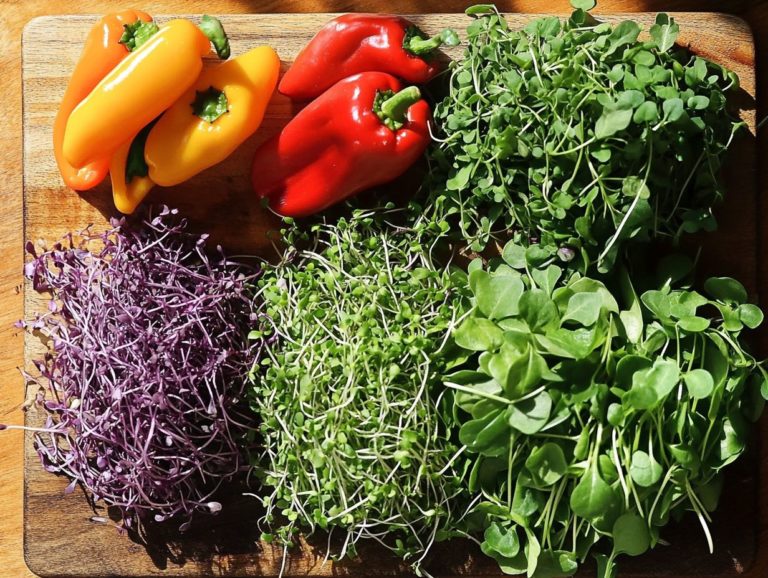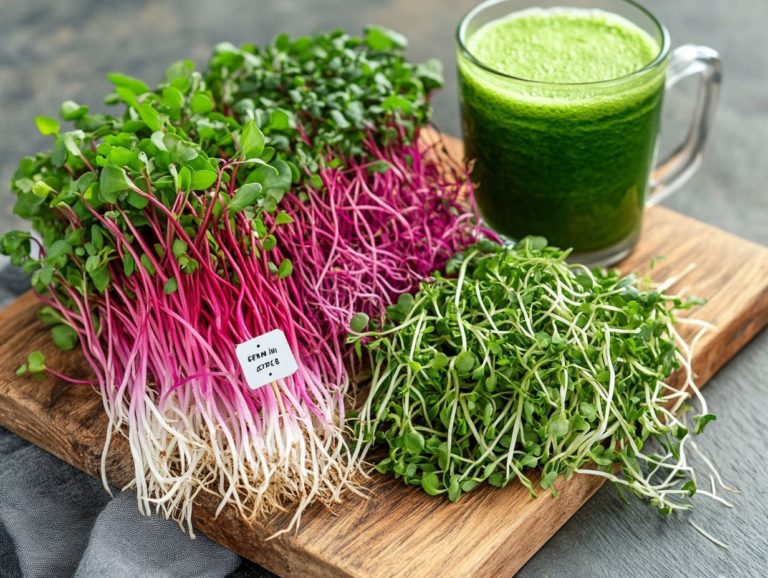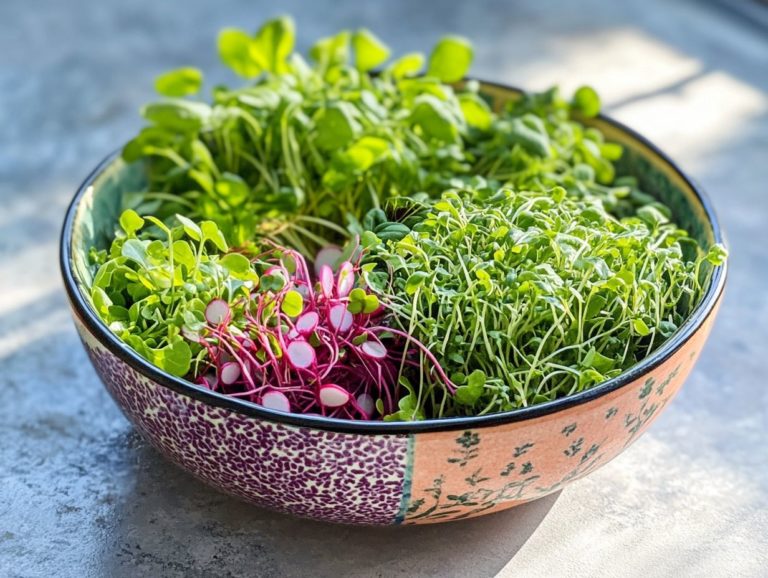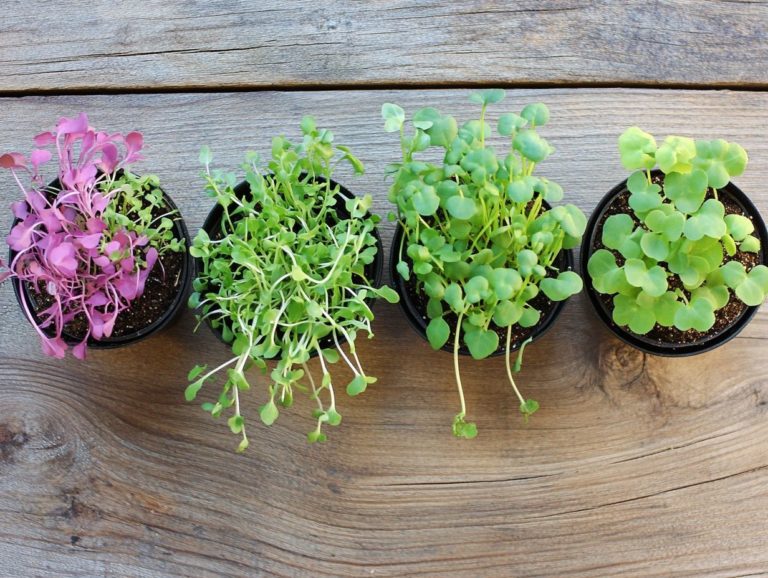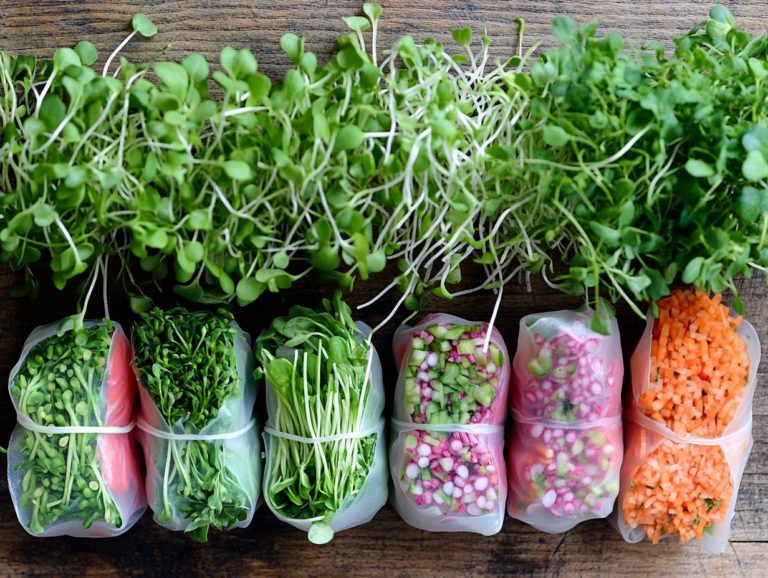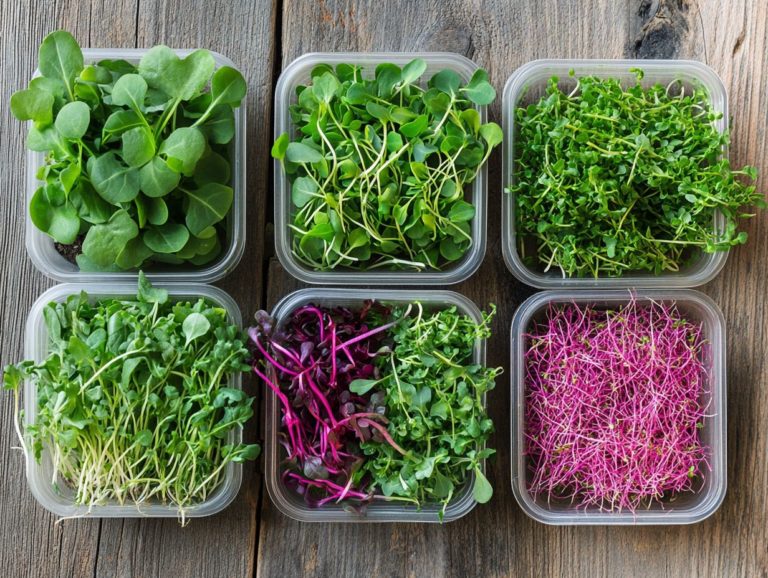5 Microgreen Varieties Perfect for Juicing
Microgreens are vibrant, nutrient-rich seedlings that can truly elevate your juicing experience.
Discover five standout varieties wheatgrass, kale, spinach, broccoli, and alfalfa that are not only easy to grow but also packed with flavor and health benefits.
You ll learn about what microgreens are, the nutritional advantages they offer, how to effortlessly incorporate them into your juices, the best juicing techniques, and some delectable recipe ideas.
Prepare to nourish your body with these green powerhouses!
Contents
Key Takeaways:
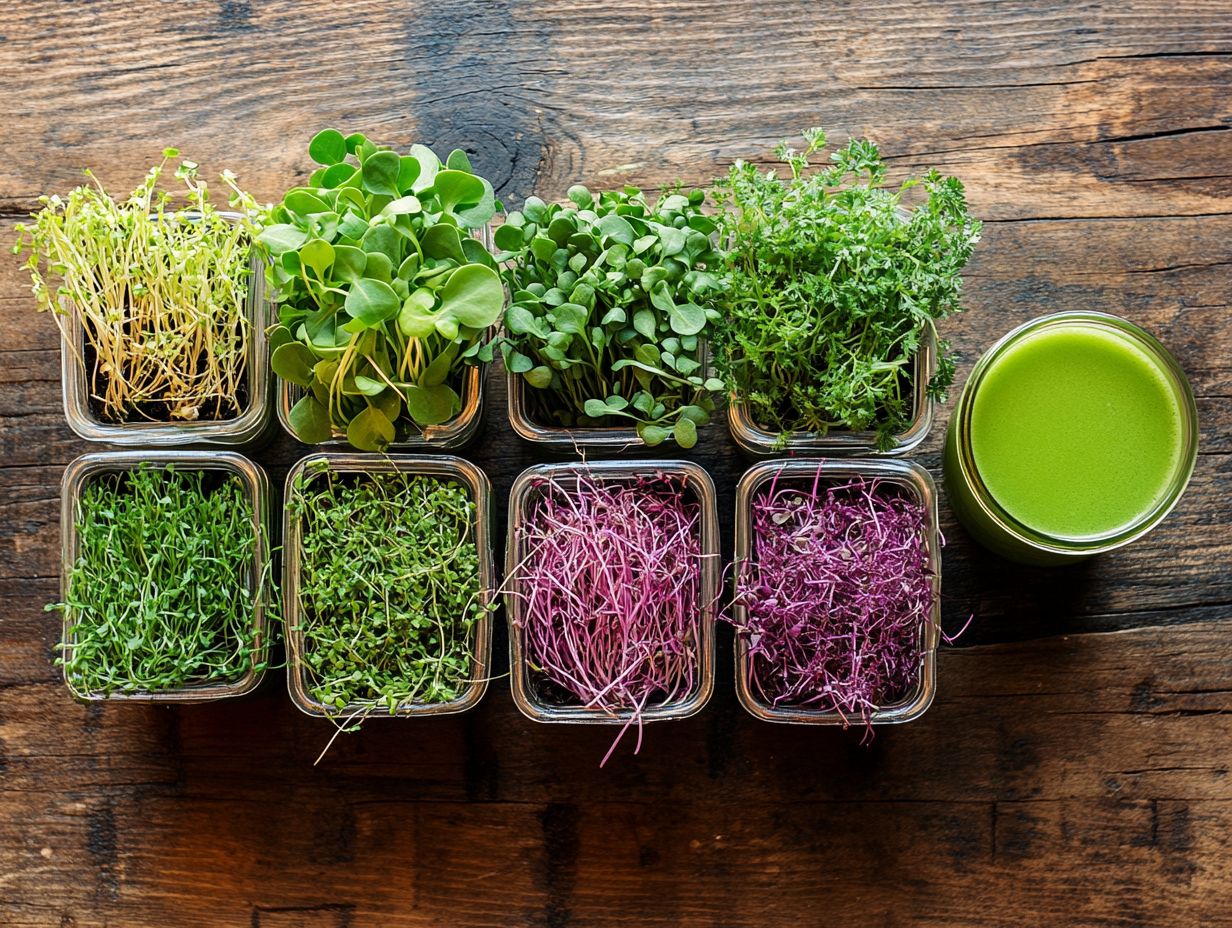
- Try incorporating mustard greens into your juices for a unique flavor.
- Wheatgrass is a popular microgreen variety perfect for juicing due to its high levels of antioxidants and detoxifying properties.
- Kale microgreens are packed with essential vitamins and minerals, making them a nutritious addition to any juice blend.
- Spinach microgreens are a great source of iron and can add a refreshing, leafy flavor to your juices.
1. Wheatgrass
Wheatgrass is a nutrient-dense superfood. It has high levels of antioxidants and vitamins A and C. It has earned a loyal following among health enthusiasts and culinary experts alike.
This vibrant green powerhouse does more than just brighten your plate; it actively supports your immune health by combating oxidative stress while enhancing your overall vitality. Its rich array of phytochemicals natural compounds in plants that can help protect your health acts as a protective shield against various illnesses, promoting a robust immune response.
In cooking, wheatgrass is celebrated for its versatility. You can seamlessly incorporate it into nutrient-packed juices and smoothies, adding a fresh, earthy flavor that elevates your creations. Consider popular recipes such as blending it with bananas and spinach for a vibrant green smoothie or adding it to a refreshing citrus juice. These tasty combos not only burst with flavor but also supercharge your nutrition!
2. Kale
Kale is often hailed as a nutritional powerhouse, offering remarkable health benefits that include high levels of vitamins and minerals. It s no wonder that it has become a go-to ingredient for both home cooks and professional chefs, celebrated for its versatility in the kitchen.
Whether you re saut ing it with garlic for a delightful side dish or steaming it to preserve those essential nutrients, this leafy green has the power to elevate any meal. If you re in the mood for a refreshing crunch, consider tossing raw kale into your salads. A gentle massage with olive oil or lemon juice can work wonders, softening its texture and enhancing its flavor.
Rich in antioxidants, kale also boosts your immunity and plays a vital role in improving digestion. Its capacity to support overall wellness makes it an essential staple in any health-conscious kitchen.
3. Spinach
Spinach stands out as a leafy green powerhouse, brimming with health benefits and packed with essential nutrients like vitamins A and C. It s a go-to ingredient for a variety of culinary creations, from crisp salads to hearty soups.
This adaptable vegetable lends itself to numerous cooking methods, whether you choose to saut it, steam it, or blend it into a refreshing smoothie. Imagine elevating your omelets or pasta dishes with spinach; not only does it enhance the flavor, but it also elevates the nutritional profile, promoting eye health and providing a generous dose of iron.
You can even whip it into dips and spreads, making it easy to incorporate its health benefits into your meals in a delicious way. Whether you savor it raw in a vibrant salad or enjoy it cooked in a savory stir-fry, spinach opens the door to endless opportunities for both culinary delight and health improvement.
4. Broccoli
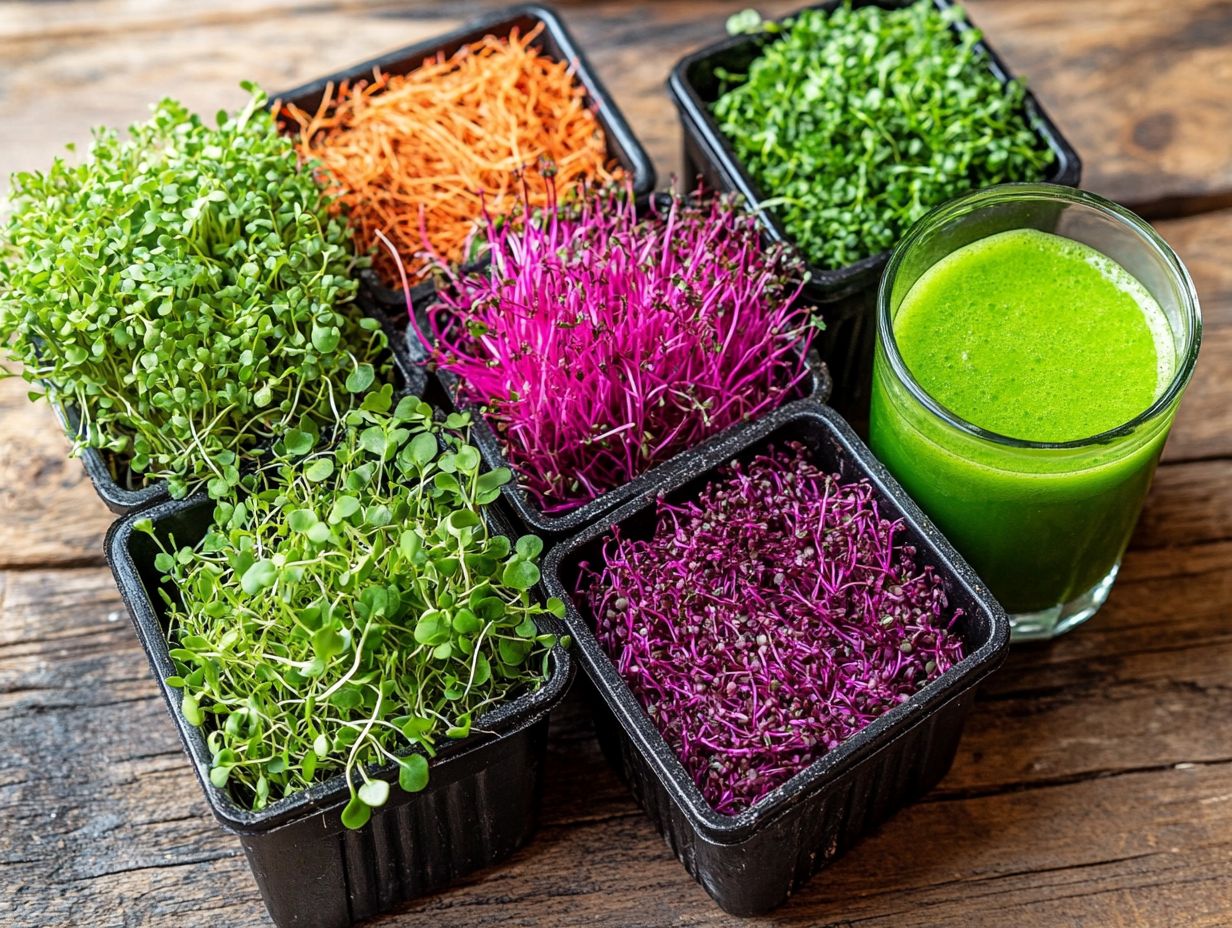
Broccoli is a true powerhouse vegetable, celebrated for its remarkable health benefits. It has a high antioxidant content that supports your overall well-being. It s no wonder that both chefs and home cooks choose it as a favorite garnish for their meals.
Rich in vitamins C and K, this healthy vegetable is often lauded for its potential in cancer prevention, especially in reducing the risk of colorectal cancer. Packed with fiber, it also plays a crucial role in aiding digestion and promoting heart health.
Broccoli shines in countless delicious dishes! Whether you choose to lightly steam it as a side dish, roast it to perfection, or toss it into stir-fries and soups, its versatility is truly unmatched.
To keep its nutrients, steam or microwave broccoli instead of boiling it. By incorporating this vibrant vegetable into your daily meals, you can boost your dishes and enjoy amazing health benefits!
5. Alfalfa
Alfalfa is a nutrient-dense microgreen that boasts impressive health benefits. Rich in vitamins and minerals, it s a great addition to salads and a beloved choice among the health-conscious.
These vibrant green shoots are packed with antioxidants, protein, and building blocks of protein that your body needs, offering a wealth of health advantages from enhancing digestion to supporting heart health. Not only is alfalfa incredibly versatile in the kitchen, but it s also a breeze to grow at home, requiring minimal space and simple care.
Whether you sprinkle it as a crunchy topping on a fresh salad, layer it in a sandwich for added texture, or blend it into smoothies for a nutrient boost, alfalfa s mild flavor elevates a variety of dishes while promoting your overall well-being. It s a popular choice for meal garnishes!
What Are Microgreens and Why Are They Good for Juicing?
Microgreens are young, edible wonders packed with flavor and nutrition, making them an exceptional choice for your juicing endeavors. These tiny greens are brimming with vitamins, minerals, and antioxidants, offering a plethora of health benefits that can elevate any juice recipe or culinary masterpiece you create.
Harvested just after the first true leaves emerge, microgreens boast a nutrient profile that s at its very best. Research indicates that certain microgreens can contain up to 40 times more nutrients than their mature counterparts, presenting an incredible opportunity to boost your immune system and enhance your overall well-being.
Perfect for juicing, they blend seamlessly into vibrant, nutrient-dense beverages without overwhelming the palate. Common varieties you might consider include:
- Basil
- Arugula
- Radish microgreens
- Beet microgreens
Each of these options brings distinct flavors and additional therapeutic qualities, ready to transform your juice recipes into something truly special. Microgreens showcase versatility!
What Are the Nutritional Benefits of Microgreens?
Microgreens are celebrated for their concentrated nutrients, offering an impressive array of health benefits that elevate any diet. These tiny powerhouses pack more vitamins and minerals per ounce than their mature counterparts, often delivering nutrient concentrations that can be several times higher.
Take broccoli as an example; while mature broccoli is known for its vitamin K content, broccoli microgreens can provide even more. They bolster bone health and enhance blood clotting. Additionally, the vitamin C levels in microgreens like radish and mustard greens can significantly strengthen your immune system compared to their adult variations.
But it doesn’t stop there! These microplants also contain essential minerals like iron and magnesium, which are vital for your overall health and wellness. This underscores their potential as not just a garnish, but a valuable addition to both everyday meals and health-focused diets.
How Can Microgreens Be Used in Juicing?
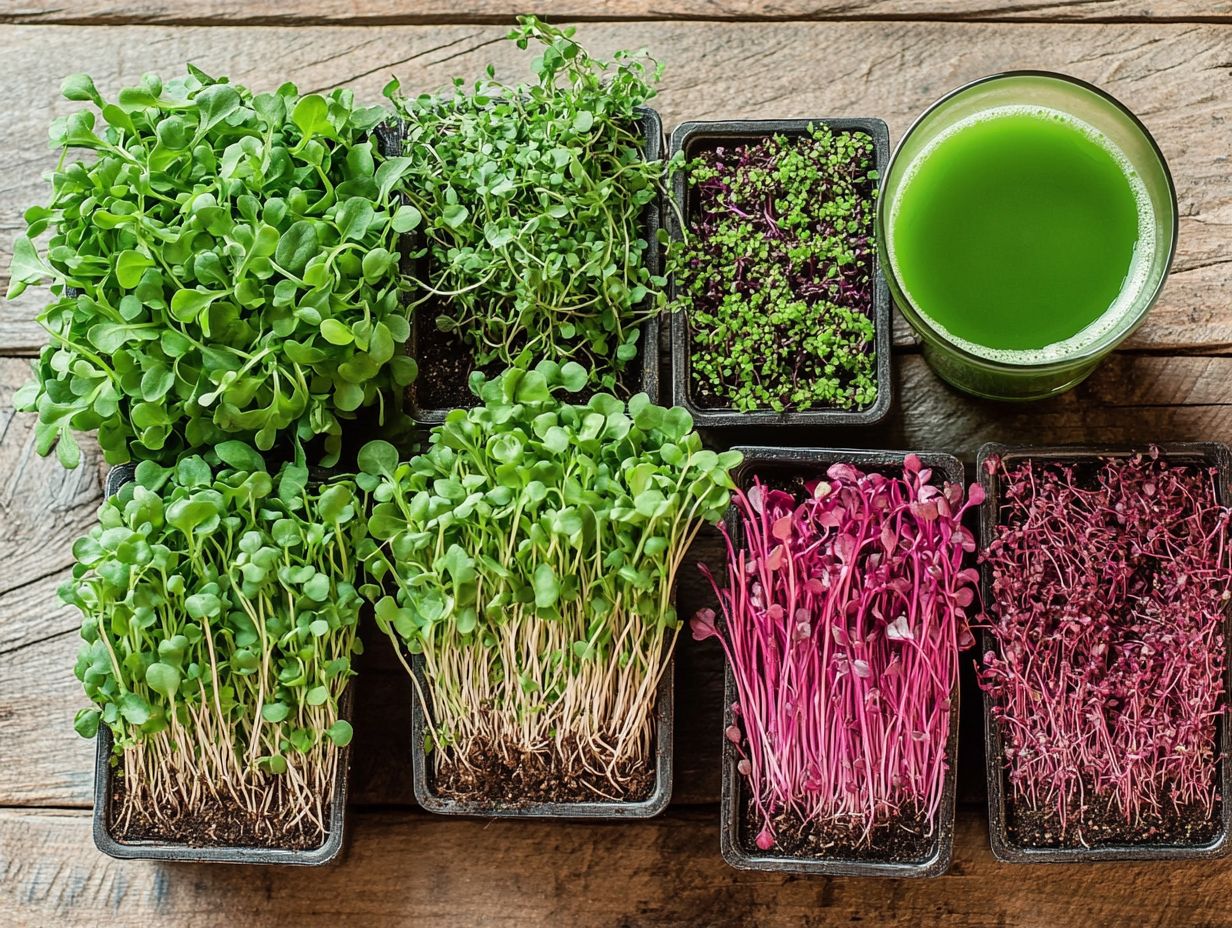
Microgreens can effortlessly elevate your juicing game. They infuse beverages with a burst of flavor and a wealth of health benefits. Not only do they enhance taste, but they also deliver concentrated nutrients that boost your drink s nutritional value.
By experimenting with varieties such as peppery arugula, zesty radish, or mildly sweet pea shoots, you can craft exciting combinations that tantalize your palate. These tiny greens are packed with vitamins and antioxidants, and you can explore the best microgreens for nutritional value to support your overall well-being.
Consider pairing microgreens with fruits like apples and berries to balance out any bitterness while enhancing their natural taste. Mixing them with nutrient-rich vegetables like spinach or kale can elevate your juice s nutritional profile significantly.
A sprinkle of lemon or ginger can take the flavor to the next level, transforming each sip into a refreshing and wholesome experience full of flavor components.
What Are the Best Ways to Grow Microgreens for Juicing?
Growing microgreens for juicing is a breeze and perfect for anyone eager to dive into home gardening. With the right seed trays, quality soil, and even some hydroponic techniques a method of growing plants in water without soil you can cultivate vibrant, flavorful microgreens in no time.
These little greens deliver an explosion of flavor and bring a wealth of health benefits to the table. They provide essential vitamins and minerals that elevate your daily juice. If you’re just starting out, consider exploring microgreen varieties like quick-germinating spinach, kale, and sunflower, which thrive in controlled conditions.
Utilize a well-lit area or invest in grow lights to ensure optimal growth, as these seedlings crave plenty of sunlight. Hydroponic systems streamline maintenance by eliminating soil, allowing for faster harvests.
By keeping an eye on nutrient levels and water, anyone can easily achieve a lush crop that s ready to juice.
What Are the Different Types of Juicers That Can Be Used for Microgreens?
There are various types of juicers for extracting juice from microgreens, each with distinct advantages tailored to your juicing techniques. This ensures you can capitalize on the health benefits of these nutrient-dense greens.
Among the most sought-after options are centrifugal and masticating juicers. Centrifugal juicers, celebrated for their speed, are perfect if you re in a hurry. However, they can generate more heat, leading to some nutrient loss. Masticating juicers operate at a leisurely pace, meticulously crushing and pressing the greens to preserve more vitamins and enzymes.
When deciding between these two types, consider factors such as ease of cleaning, noise level, and whether you value convenience over nutrient retention. Each factor can significantly enhance your juicing experience.
What Are Some Delicious Microgreen Juice Recipes?
Get ready to craft delicious microgreen juice recipes that will blow your taste buds away! These vibrant greens result in refreshing beverages brimming with nutrients perfect for any time of day.
Imagine the possibilities with these lush greens, from the peppery notes of arugula to the sweet undertones of basil. You can skillfully pair them with an array of fruits, vegetables, and herbs to create a delightful symphony of flavors.
For example, mixing radish microgreens with crisp cucumber and a splash of zesty lime offers a refreshing drink that tantalizes your taste buds while aiding in digestion and hydration.
Consider blending sunflower microgreens with juicy apples and a dash of ginger to create a delightful sweetness while infusing your drink with essential vitamins and minerals. These creative combinations enhance flavor profiles and elevate health benefits, making each sip a truly enjoyable and nourishing experience.
Start your juicing adventure today and reap the health benefits!
Frequently Asked Questions
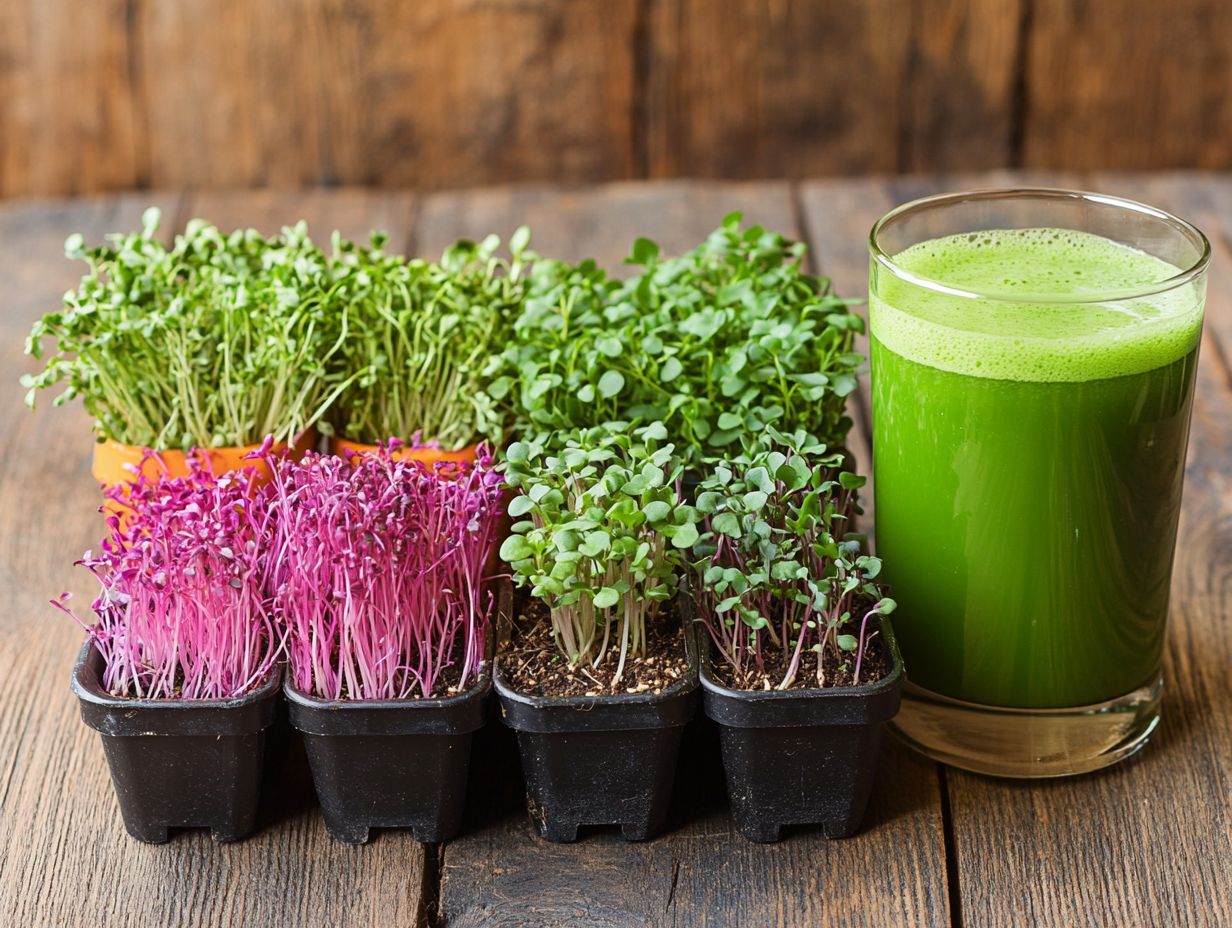
What are microgreens and why are they good for juicing?
Microgreens are young vegetable greens harvested early, usually after the first true leaves develop. They are packed with nutrients and offer concentrated flavor, making them excellent for juicing.
What are some popular microgreen varieties for juicing?
Some popular microgreen varieties for juicing include broccoli, kale, spinach, sunflower, and pea shoots. These greens are rich in vitamins and easy to grow at home.
Can you mix different types of microgreens for juicing?
You can mix different types of microgreens for juicing to create unique flavors and maximize nutrition. Just remember to rinse them thoroughly before juicing.
How do you store microgreens for juicing?
To store microgreens, wrap them in a damp paper towel and place them in a plastic bag or container. Store them in the refrigerator and use within 3-5 days for optimal freshness.
Are all microgreen varieties safe for juicing?
Not all microgreens are suitable for juicing. Some may have a strong or bitter taste. It’s best to stick with popular varieties like broccoli, kale, and spinach for juicing.
Can you grow your own microgreens for juicing?
Yes! You can easily grow your own microgreens at home. All you need is a shallow tray, potting soil, and seeds. They can thrive indoors or outdoors, making fresh juice just a step away!

